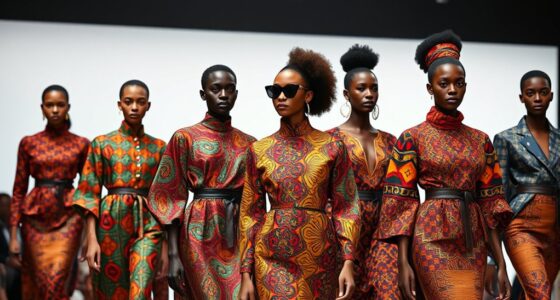Sneakers started as functional athletic gear focused on performance, with lightweight materials and durable soles. Over time, they blended style with new technology, becoming symbols of personality and culture. Icons from sports and music helped elevate their popularity, turning sneakers into statements of identity and rebellion. Limited editions and collaborations fueled their status as collectibles. Today, sneakers reflect a dynamic mix of fashion, culture, and self-expression—discover how they transformed beyond just sportswear.
Key Takeaways
- Sneakers initially focused on athletic performance, emphasizing lightweight, durable, and technologically advanced materials for sports.
- They evolved from purely functional gear to fashion statements blending style with innovation.
- Cultural influences from sports, music, and street movements transformed sneakers into symbols of identity and rebellion.
- Limited editions and collaborations increased sneaker collectibility, turning them into cultural artifacts and art pieces.
- Today, sneakers serve as a dynamic intersection of function, fashion, and cultural expression in global society.
Have you ever wondered how sneakers have transformed from simple athletic gear into a global fashion statement? It’s a fascinating journey that begins with sneaker design, which has continually evolved to reflect changing tastes, technologies, and cultural influences. In the early days, sneaker design focused mainly on function—lightweight materials, cushioned soles, and durable uppers made for sports. But as sneakers gained popularity, designers started experimenting beyond the athletic sphere, blending style with innovation. The sleek lines of a running shoe or the bold colors of a basketball sneaker became more than just performance gear; they started to embody personality and identity. Over time, sneaker design began to incorporate diverse influences—from street art to high fashion—making each pair a canvas for cultural expression. This shift was driven by a desire to stand out, to communicate individuality, and to connect with broader social movements.
Cultural influence played a major role in shaping the sneaker landscape. As sneakers moved from gym floors to city streets, they became symbols of rebellion, status, and belonging. Sneakers associated with sports stars, music icons, and cultural icons gained a kind of mythic status, influencing what people wore and how they expressed themselves. Brands like Nike, Adidas, and Puma didn’t just sell shoes; they created cultural moments that resonated with youth identity and societal shifts. For example, the rise of hip-hop and skateboarding scenes gave rise to sneakers that weren’t just functional but were also embedded with cultural symbolism. Wearing a particular brand or style could signify allegiance to a movement or community, turning sneakers into powerful forms of cultural communication.
As sneaker design has continued to evolve, so has its cultural significance. Limited editions, collaborations with artists, and streetwear-inspired designs have transformed sneakers into collectible art pieces. The influence of subcultures—such as sneakerheads—has driven this evolution, with enthusiasts passionately seeking rare or unique pairs. This cultural influence extends beyond fashion; it shapes trends, influences marketing strategies, and even impacts social conversations about race, class, and identity. Additionally, the rise of hackathons related to fashion technology demonstrates how innovation continues to play a role in sneaker development, blending digital design with manufacturing. You can see this everywhere: from high-profile runway shows to local street corners, sneakers serve as a dynamic intersection of function, style, and cultural expression. They’re no longer just athletic gear but are woven into the fabric of modern identity, reflecting a global shift in how we see ourselves and others.
Frequently Asked Questions
How Have Sneaker Materials Changed Over Time?
You see, sneaker materials have transformed considerably over time. Thanks to technological advancements, brands now incorporate innovative fabrics like breathable mesh, lightweight foam, and durable rubber. Eco-friendly innovations also play a role, with sustainable materials such as recycled plastics and organic cotton becoming more common. These changes make sneakers more comfortable, durable, and environmentally conscious, reflecting both technological progress and a growing awareness of sustainability in the footwear industry.
What Are the Most Influential Sneaker Collaborations?
You should know that the most influential sneaker collaborations often feature limited editions and celebrity endorsements. These partnerships create buzz and exclusivity, driving hype and demand. Brands like Nike with Travis Scott or Adidas with Kanye West have transformed the sneaker scene. You’ll find that limited editions and celebrity-driven designs shape trends, making these collaborations highly sought after by collectors and sneakerheads alike, fueling the sneaker culture’s growth worldwide.
How Do Sneaker Brands Influence Fashion Trends?
Sneaker brands influence fashion trends by leveraging sneaker branding and celebrity endorsements, which capture your attention and set new style standards. When brands feature popular celebrities or athletes, you’re more likely to adopt their looks. These endorsements create buzz and drive demand, shaping what’s fashionable. As a result, sneaker brands don’t just sell shoes—they shape your style choices and influence broader fashion movements.
What Is the Impact of Sneaker Culture Worldwide?
You see sneaker culture’s global impact through sneaker activism and sustainability efforts. It empowers you to support brands that promote ethical practices and environmental responsibility. Worldwide, sneaker culture influences fashion, music, and social movements, encouraging a sense of community and identity. Your involvement can push brands toward more sustainable sneaker production, making a positive difference while expressing your style and values.
How Do Sneaker Collectibility and Resale Markets Work?
Sneaker collectibility and resale markets are like a high-stakes game where market valuation shifts with rarity factors. You buy limited-edition releases and hope their value climbs, driven by scarcity and hype. Resellers buy sneakers at retail and sell them later for a profit, with prices soaring for rare, sought-after pairs. Your success depends on understanding what makes certain sneakers more collectible and how market dynamics influence their worth.
Conclusion
You see, sneakers have shifted from simple sportswear to symbols of style, status, and identity. They embody innovation and self-expression, blending functionality with fashion. They challenge norms and inspire creativity, turning everyday footwear into cultural icons. Ultimately, sneakers are more than just shoes—they’re a movement, a statement, a story. As they continue to evolve, they invite you to embrace change, to celebrate individuality, and to step confidently into the future.







